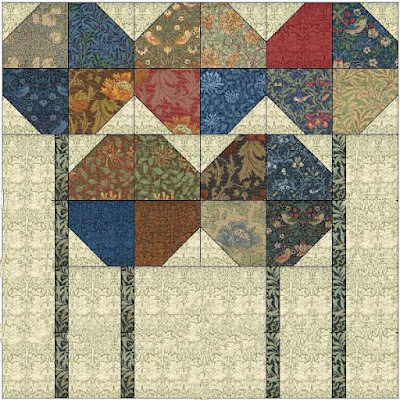Hexagons carefully cut from a stripe.
Maybe 1870-1890
British 1820–50. The Metropolitan Museum of Art
Gift of Adele Pharo Azar, in memory of her late husband,
Jemile Wehby Azar
Inspired by the May quilt on my Metropolitan Museum kitchen calendar I've been looking at hexagon patchwork, seeing if there is anything new on sources, etc.
The standard citation for first publication in the U.S. is still "1831
The American Girl's Book," in which it was called hexagon, six-sided or honey-comb patch-work. You can read this book at Google Books--- I had no idea it was a book, I always thought it was a magazine.
Design and text were copied in 1835 in Godey's Lady's Book---a magazine. By then Americans had been making the quilts for decades. Britons seem to have developed the style first. The earliest date-inscribed hexagon quilt found so far is attributed to Anna Ruggles of the British Isles, dated 1796 in the collection of International Quilt Museum.
From Bridget Long's dissertation Anonymous Needlework
The earliest date-inscribed American-made hexagon patchwork (an unfinished piece) has been dated by the newspaper templates as 1792-1803, attributed to Catherine and Susan Springer of New Castle County, Delaware.
Of course, the papers could be earlier than the patchwork.
Barbara Schaffer took detail photos when it was on display
a few years ago.
I also saw a list made about ten years ago by Lynne Z. Bassett, expert in early quilts. She noted:
- The Newark Museum holds an unfinished top dated 1793.
- The Bache family of Philadelphia holds a 1790s unfinished top.
- The Wadsworth Atheneum Museum of Art holds a quilt made by Sarah Ewalt Spencer (1766−1842) of Bedford, Pennsylvania, acc.no.1982.165, dated 1794.
In 1860 Peterson's Magazine explained the basics of making template patchwork (basting fabric over paper templates.) Tin for the basic reusable pattern, paper for the templates and scraps from the rag bag.
Below a description of a quilt from the Huguenot Society of South Carolina.
Suzette should not have cut up the deeds to the French land but paper WAS expensive. Author above makes a common error in confusing octagon (8 sides) with hexagon (6 sides.)
Six sides---hexagon
Pentagons (5 sides) and hexagons will tesselate. Octagons
need another piece (square or triangle in the corners.)
Winterthur Museum
Detail of a hexagon center bordered with a field of octagon patchwork.
Update: Louise Tiemann found an 1814 reference to tessellating
patchwork in a London publication.
In 1827 a Charleston newspaper was telling readers about
hexagon quilts in England.
I haven't seen any early instructions for what we'd call fussy cutting,
centering the hexagon on a print figure.
A spectacular piece
In the collection of the Royal Ontario Museum
in Canada.
Their caption: Pieced quilt. Made in England; used in Barbados. 1800-1825.#949.259 Gift of Mr. and Mrs. R.J. Mercur. Barbados---quilts of the West Indies--- completely unexplored territory quilt history wise. At one time Barbados was the most prosperous of the British Caribbean colonies.
Some one was quite taken with an early roller-print
style of "storm clouds"
Similar print at the bottom in this one from Lila Laurette Carroll's
collection.
Detail from one from the Townsend-Pope family
quilts of South Carolina that Sharon Pinka has been studying.
Hexagon in a square from a New York sampler I own,
early 1860s.
Attributed to Hannah Wallis, Philadelphia
DAR Museum Collection
Susan Mueller recently posted pictures of a pair of blocks she was lucky enough to find at an American estate sale. They look to be block-prints---early 19th century. The paper foundations are newspapers dated 1800 to 1808.
The papers show just enough information we can guess
they were American-made.
A 1791 New York directory lists "Reily, Terence, hatter, 36, Wall street."
A Dr. Benjamin M. Stillman was a Revolutionary War soldier from
Massachusetts
An Elijah Bemis, born 1770, lived in Worcester, Massachusetts.
Mid 20th-century American
This intrepid quiltmaker probably called her design Grandmother's Flower Garden, a
20th-century name. What did their grandmothers' generation call the design?
In 1856 "Katinka" published an American tale
Abbie Nott & Other Knotts, in which a hexagon quilt is named: "Job's troubles, that is to say, innumerable bits of red, yellow, and vari-colored calico, cut in hexagonal form." See the bottom of the page for speculation as to who Katinka really was.
Another possible name:
Job's Patience.
Job's Troubles is an often-used nineteenth-century name.
http://quilt1812warandpiecing.blogspot.com/2012/08/mosaic-patchwork.html
Who was Katinka? Was she Walt Whitman wonders Roger Asselineau in
The Evolution of Walt Whitman (University of Iowa Press, 1999.)























































